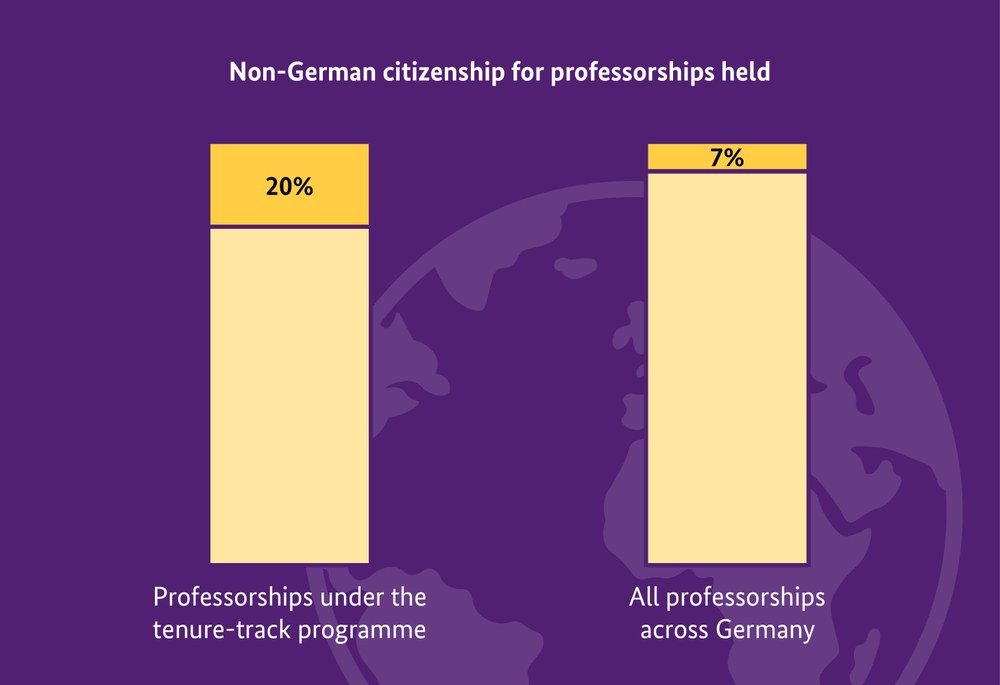
Tenure-Track Programme

In 2016, Germany’s federal states (Länder) and the Federal Ministry of Education and Research joined forces to launch the Joint Federal Government-Länder Funding Programme for Junior Academics. The goal of the programme is to recruit the best scientists in an early career phase from at home and abroad, and to enable predictable and transparent research careers for them.
With 971 professorships filled at 75 universities, 97 percent of the target of 1000 additional professorships was achieved. The funded universities aim to permanently establish the tenure-track professorship career path.
JOINT FEDERAL GOVERNMENT-LÄNDER FUNDING PROGRAMME FOR JUNIOR ACADEMICS

The tenure-track professorship was introduced in Germany on the basis of a joint initiative by the federal and state governments. In two funding approval rounds, a total of 75 universities receive funding for up to 13 years for the permanent implementation of the new career path.
Establishing the tenure-track professorship at German universities and opening up this career path for as many scientists as possible from Germanyand abroad are key elements of the Joint Federal Government-Länder Funding Programme for Junior Academics. A total of 971 tenure-track professorships have been filled.
Programme objectives
|
|
|
|
|
|
|
Cooperation in the programme
|
|
|

EFFECTIVENESS OF THE TENURE-TRACK PROGRAMME

Surveys and figures illustrate the effectiveness of the Joint Federal Government-Länder Funding Programme for Junior Academics. The 2023 monitoring report of the Joint Scientific Conference (GWK) and the 2024 report on the first accompanying evaluation of the funding programme examine the effectiveness of the programme to date.
The tenure track makes the German scientific landscape...
... more international
Around one quarter of the new tenure track professors were employed outside of Germany directly before taking the position. One fifth of the professors funded under the programme did not have German citizenship. For comparison: Across Germany, seven per cent of professors had a foreign citizenship in 2022.

… more female
Out of a total of 34,915 applicants for tenure-track professorship funded under the programme that were advertised up to 1 July 2023, 11,320 or 32 per cent were women. Nearly half the tenure-track professorships were awarded to female applicants. For comparison: Across Germany, the proportion of women for all professorships was just 28 per cent in 2022.

… younger
In general, the decision to permanently remain in the field of science is made earlier with the tenure-track professorship than under other career models, since the initial appointment is made at a comparatively young age and the tenure evaluation is typically completed six years after that. The tenure track professors funded under the programme were 35.9 years old on average when initially appointed.

… and more sought-after
34,915 applications for tenure-track professorships were received by 1 July 2023. Of the tenure track professors appointed by then, 295 previously pursued a different career path to the professorship, mainly junior research group leadership and a junior professorship without tenure track.
FUNDED UNIVERSITIES

971 tenure-track professorships were created at 75 universities in Germany under the Federal Government-Länder Funding Programme since 2018. The tenure-track professorship career path was permanently implemented by the funded universities.
Further information
-
Administrative agreement on the tenure track programme (PDF file, german only)
-
Funding guideline, first funding approval round (2017) (PDF file, german only)
-
Funding guideline, second funding approval round (2019) (PDF file, german only)
-
Monitoring report on the tenure track programme 2023 (PDF file, german only)